In this Article:
There are a plethora of cartridges available for civilians on today’s market. Deciding on which cartridge fits the hunting or shooting competitions you have in mind can be daunting, and this article is meant to provide you with an in-depth comparison of two of the more historical hunting cartridges in the US; the .30-30 vs .30-06.
Both cartridges are entrenched in hunting lore and come with a passionate and loyal following. While popular, these two cartridges fill very different niches of the hunting world.
In this article, we will take a look at the ballistic and other properties of these two cartridges. Not with the intention of declaring one better than the other, but to better understand each cartridges application and under which hunting situation each is better suited for.
A Brief History
Before we jump into our .30-30 vs .30-06 comparison, we wanted to briefly touch on where these cartridges came from and how they have been used since their introduction. We will also take a look at some of the design specs of the cartridges and compare the two. We will also list several rounds for each cartridge that we will be comparing throughout the article.
.30-30 Winchester
The .30-30 Win (thirty-thirty) is one of the oldest hunting cartridges, but given that it is still a popular cartridge hint at its effectiveness. It was one of the first cartridges to be made with smokeless powder and was introduced in 1895. The name comes from the bullet diameter (.308) and the amount of powder originally used in the cartridge (30 grains).
Because the .30-30 is most often used in lever action firearms with tubular magazines, bullets are often only designed with flat or rounded noses to keep from striking the primer of the next round in the magazine. Because of this, the performance seen with other rifles with ballistic tips are often not seen. Even though this is often the case, there have been more modern rounds come into production and anyone who has used a lever action .30-30 can’t help but admit there is something special about it. And as much as sentimentalism plays a part in the firearms and cartridges we use, we will try to keep it to the numbers in this article.
The .30- 30 is a little more limited in the weight of bullets because of the cartridge dimensions and are usually found in 150-170 grain weights with some lighter weights also available.
.30-06 Springfield
The .30-06 (thirty-ought-six) was developed in 1906 in response to advances in cartridge design in foreign nations. Its name comes from the bullet diameter (.308) and the year it was produced (1906). The .30-06 Springfield saw combat in several wars until it was replaced in the late 70’s.
Though retired from military service, the .30-06 is a well-known hunting cartridge that is sought after for its velocity, power, and flat trajectory which all make it able to take down larger game cleanly up to and beyond 500 yards.
The .30-06 is widely available in just about any retail store that sells ammunition. It has a huge selection of bullet weights as well as designs that allow .30-06 to be used in a variety of hunting situations. The .30-06 can also be an extremely hot load when hand loaded, increasing its performance greatly.
Specs
| .30-30 Winchester | .30-06 Springfield | |
|---|---|---|
| Parent Casing | .30-03 | |
| Bullet Diameter | 0.308†| 0.308†|
| Neck Diameter | 0.330†| 0.340†|
| Base Diameter | 0.422†| 0.471†|
| Case Length | 2.039†| 2.494†|
| Case Capacity | 45gr | 68gr |
| Max Pressure (SAAMI) | 42,000psi | 60,200psi |
There is quite a bit of information that we can gain just from looking at the differences in case and bullet dimensions for each cartridge. Just an initial scan through the two will let you know that these cartridges have some distinct differences. From looking at the specs between the .30-30 vs .30-06, we see that the .30-30 Win is a much smaller cartridge than the .30-06. While the bullet diameter is the same, the casings have some differences. The .30-30 has a much smaller base diameter than the .30-06 and makes it so the .30-30 cannot hold near the powder charge of the .30-06 or hold up to the amount of pressure that the .30-06 can. As you can imagine, this is going to allow the .30-06 to use heavier bullets without sacrificing ballistic properties. We will shortly see how varied the properties of these two cartridges are, and the cartridge dimensions are a large factor.
To examine how these two cartridges behave we have selected ten rounds, five from each cartridge, and we will compare and contrast their behavior in several ballistic and other performance characteristics. We have tried to cover a range of bullet weights, loads, and bullet design to give us a diverse set of available rounds for each cartridge.
Even with ten selected rounds, we acknowledge that this is still a small sample size compared to what is on the market. We are still confident that the conclusions we can reach give us a clear window into these two cartridges. We have selected five popular rounds that are most often used in the field so even though there are a lot more options out there, what matters for most marksmen and hunters is what is most available. Another reason we are confident is that we have selected a good range of available rounds with varying bullet weights and designs. We have listed these rounds below.
Below we have listed our choices.
 .30-30 Remington Core-Lokt SP 150gr
.30-30 Remington Core-Lokt SP 150gr .30-30 Winchester Ballistic Silvertip 150gr
.30-30 Winchester Ballistic Silvertip 150gr .30-30 Federal Premium Nosler Partition 170gr
.30-30 Federal Premium Nosler Partition 170gr .30-30 Federal Power-Shok Jacketed Hollow Point 125gr
.30-30 Federal Power-Shok Jacketed Hollow Point 125gr .30-30 Hornady Monoflex Full Boar 140gr
.30-30 Hornady Monoflex Full Boar 140gr
 .30-06 Federal Vital-Shok Nosler Partition 165gr
.30-06 Federal Vital-Shok Nosler Partition 165gr .30-06 Hornady 150gr GMX Superformance
.30-06 Hornady 150gr GMX Superformance .30-06 Federal American Eagle FMJ 150gr
.30-06 Federal American Eagle FMJ 150gr .30-06 Nosler Custom Hand Loaded AccuBond 200gr
.30-06 Nosler Custom Hand Loaded AccuBond 200gr .30-06 Federal Gold Medal Sierra Matchking 168gr
.30-06 Federal Gold Medal Sierra Matchking 168gr
All of these rounds are common and popular factory loads on the market. You might not see your favorite round on this list, and that does not reflect a stance that we don’t think it deserves to be on this list. We simply have to cut off the number at some point, and ten seemed like a nice round number that wouldn’t result in cluttered graphs where it was impossible to say anything.
And just in case you are now sitting and wondering how we could gain any meaningful data from only ten rounds, we want to let you know that we actually have compiled forty total factory loads. At the end of each section, we will list the averages for both cartridges that come from this larger sample size. And while it is still not a fully comprehensive list, it is large enough and diverse enough to give an accurate representation of the cartridges. We have listed all of these rounds at the end of the article.
Before we get into the meat of this article, we do want to briefly touch on the data we are using and how it was gathered. All of the data that you are going to see in this article has been taken from the manufacturer’s website or generated from online ballistic generators. Because these are computer generated numbers, they may not be the exact numbers you would get from firing these rounds through your platform. This is common since just about every gun has its own ballistics profile. Because all of this data is computer generated, the trends in this article hold up to data generated in the field and because the numbers can vary from gun to gun and can be impacted by environmental factors, computer generated data is one of the best methods for simply comparing cartridges such as the .30-30 vs .30-06.
Recoil
For experienced hunters, there are not many hunting or competition cartridges normally used that will put them off from shooting because of recoil. Still, recoil does affect performance, most notably accuracy when it is high enough to cause flinching when shooting. Again, this mainly a concern for younger or new shooters. High recoil can cause the shooter to flinch which can throw off the bullets trajectory and cause a missed shot. High recoil also makes it more difficult to realign the rifle for quick follow up shots.
What we are going to look at in this section is the actual recoil energy (ft.lb) that is generated from firing rounds of each cartridge. We also want to mention that what we are measuring is not “felt recoil,” the recoil you feel when shooting, Felt recoil relies on a lot of other variables that we can’t account for. And the recoil energy is going to loosely translate to the amount of felt recoil.
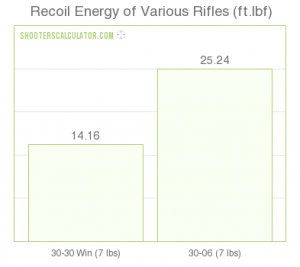
First, let’s look at the recoil energy of averages for both the .30-30 and .30-06 cartridges that was generated using the data provided by the ballistic categories (Graph 1). It’s a pretty dramatic difference in recoil energy between the two, with the .30-06 round generating nearly double the recoil energy of the .30-30. Not only does the .30-06 generate more recoil than the .30-30 but it is over 20ft.lb of energy which is accepted as enough to influence shots when used by inexperienced shooters or in situations where you have to get a shot off quickly.
Let’s see if this trend holds when we look at several different rounds of each cartridge (Graph 2).
To generate this data, we used the muzzle velocities provided by the manufacturer, a 7lb rifle, and the powder charges based on common load data from various sources. For the powder charge, we also went pretty conservative to try and match the manufacturers who often err on the side of caution. Because of all this, these numbers are not going to be right on the nose. They can sway plus or minus a couple pounds, but the overall trends that we see should hold.
As the previous graph, we see each of the .30-06 rounds generating a significantly greater amount of force than the .30-30 rounds. For some, this might not be a factor in their decision, but it does impact applications which we will discuss at the end of the article. All of the .30-06 rounds produce more than 20ft.lbs of energy with several generating more than 23ft.lb. On the other hand, the .30-30 rounds are much more manageable regarding recoil with all of them falling between 12 and 15ft.lbs of energy.
Let’s take a look at the average recoil data that was calculated from the full data set.
Average Recoil (ft.lb)
| .30-06 Springfield | .30-30 Winchester |
|---|---|
| 23.2 | 14.18 |
This data backs up what we saw with the smaller sample size. There is no question that the .30-06 rounds are producing a lot more recoil energy than the .30-30 rounds. And what we have seen from just looking at the cartridge specifications, it really isn’t a surprise that we see such a difference between these two cartridges.
Ballistics
When comparing cartridges, in this case, the .30-30 vs .30-06, ballistic properties are understandably an important component of a thorough comparison. We will look at several ballistic properties of the two cartridges to draw conclusions from trends we see. From these conclusions, we can better understand under which situations, one or both cartridges would be suitable to use. We will look at the velocity, the ballistic coefficients, and the trajectory of these ten rounds. And while we break down ballistics into individual categories, they all influence each other. So, while looking at them individually is simple for comparison, you need to take all of this information together to get the full picture of each round and each type of cartridge. We will attempt to bring it all together in the application section.
As we move through these categories, you might notice that the numbers here seem much lower than some data you might see at other sites or forums. These are factory loads that are usually not loaded to max capacity regarding powder and are not near as hot as hand loaded rounds.
Velocity
Our first subsection for cartridge ballistics is velocity. The velocity of a bullet leaving the muzzle tells us a lot about how the bullet will fly. Faster velocities mean that wind and gravity will have less of an impact on the bullet during its flight path. Velocity is also important to hunters because it also influences terminal ballistics and how well the bullet will expand and transfer kinetic energy to the target. Hotter loads often refer to the velocity of the round. And while factory loads usually are not pushing the fps limits of the cartridge, you might see hand loaders showing much higher velocities than what you will see with a lot of factory loads. Sometimes, a load can be too hot and it burns up a barrel quickly or you get an unstable bullet in the air. It’s not as relevant when talking about factory loads, but it’s a misconception out there that hotter rounds are better rounds.
The velocity is a key performance spec also because it has heavy influence on just about every other performance category. All of this is a lot of checks and balances but velocity seems to be involved with just about everything. If you know the velocity and the weight of the round, you can have an idea of what the numbers will look like for a lot of other performance categories.
We will compare the ten rounds in terms of bullet velocity from the muzzle out to 500 yards (Graph 3). This data was compiled from the manufacturer.
What we see is that the .30-06 rounds have a very distinct advantage in the velocity department. The trend that we are seeing makes a lot of sense if we think about what is going on regarding design. For the most part, the bullet weights are similar but the cartridges used are much different when we compare their max capacity from our specs table. The .30-30 bullets are being pushed from a much lighter powder load than the .30-06 bullets. From the muzzle to 500 yards, the .30-30 just doesn’t have the velocity of the .30-06.
From the muzzle, we are looking at around 350 extra ft.sec on average for the .30-06 rounds leaving the muzzle than the .30-30 rounds. As the rounds move downrange, this gap begins to widen pretty drastically. By the 500 yard mark, the difference in averages between these two cartridges is nearly 900ft.s because the .30-30 rounds bleed velocity at a high rate. We also do not see any overlap between the two cartridges except at the muzzle where only the highest velocity .30-30 round is similar to the lowest velocity .30-06 round.. It is a clear advantage for the .30-06.
Both the .30-30 and the .30-06 remain at supersonic speeds out to the 300-yard mark. At the 400 yard range, several .30-30 rounds drop below supersonic speeds, and all of them do at the 500-yard mark. On the other hand, all of the .30-06 rounds remain well above the supersonic mark at 500 yards and will continue to do so for several hundred more. And as we stated earlier, this is going to be a big factor when deciding between a long-range shooting cartridge.
Below, you will find the average velocities for the two cartridges from the muzzle out to 500 yards and you will also find a table listing the average yards these rounds fall below supersonic speeds.
Average Velocity (ft/s)
| Yards | .30-06 | .30-30 |
|---|---|---|
| Muzzle | 2822 | 2311.7 |
| 100 | 2601 | 1959.5 |
| 200 | 2391 | 1644 |
| 300 | 2191.9 | 1378.25 |
| 400 | 2001 | 1178.5 |
| 500 | 1828 | 1045.9 |
When we look at the larger data set, we see the same trends between the two cartridges, although the differences between the two have widened. With 500 fps difference out of the muzzle and nearly 800fps difference at 500 yards, it is clear that the difference in performance of these two cartridges is going to be evident for a lot of categories. We also do not see hardly any overlap between individual rounds of the different cartridge type.
Average Supersonic Limit (Yards)
| .30-06 Springfield | .30-30 Winchester |
|---|---|
| 1050 | 432.8 |
A lot of marksmen, especially those who practice the art of long range shooting, are interested in the distance a round can maintain supersonic speed. The reason for this is that when a bullet falls below supersonic flight, it becomes much more unstable. So, the longer a bullet can stay above that mark, the easier it is to determine what that bullet is going to do.
From the averages, it is clear that the .30-30 Win lags behind the .30-06 in this regard. With over 600 yards difference between the two cartridge, you can see that the .30-06 might be more beneficial when having to make shots consistently beyond 500 yards.
Ballistic Coefficient (BC)
The ballistic coefficient is a number that is derived from several bullets and cartridge variables. The actual number gives you an idea of how well a bullet can resist wind drag and wind drift. The higher the BC, the harder it is for the bullet to be pulled off target and the better the velocity and trajectory is going to be. So while a higher BC doesn’t necessarily mean the bullet is going to be more accurate, it does make it easier to adjust shot placement at extended ranges.
So, let’s take a look at our ten rounds for this comparison and compare the BCs to see if there are any noticeable trends between the .30-30 vs .30-06 (Graph 4).
All of the ballistic coefficients for these rounds were compiled from the manufacture.
It’s fairly obvious that the .30-06 rounds have a much higher average BC than the .30-30 rounds. The lowest BC for the .30-06 rounds is 0.41 which is significantly greater than any of the .30-30 rounds. All of the .30-06 rounds show BCs greater than .4 while the .30-30 rounds do not break the .3 mark. We mentioned briefly about the bullet design of most .30-30 rounds, and these bullets just do not provide the same aerodynamics of other cartridge bullets, including the .30-06. What this means is that the longer the shot, the higher the chance that the .30-30 round is affected by environmental factors and a lot more velocity and energy will bleed off as we saw in the previous section. We are about to look at both short and long range trajectory, and we will see how it is impacted as well.
Before we move on, take a look at the average BC between these two cartridges when we add our extra rounds. As you can see, it’s not just the rounds we selected above where we see this large difference. There is nearly two tenths of a difference between these averages, which as far as ballistic coefficients go, this is quite a gap. And while the .30-06 rounds have quite a wider range in numbers, the .30-30 rounds rarely have a BC greater than 0.3 while the .30-06 has several rounds with a ballistic coefficient reaching and exceeding 0.5.
Average Ballistic Coefficient
| .30-06 Springfield | .30-30 Winchester |
|---|---|
| 0.427 | 0.231 |
Trajectory
Before we look specifically at short and long range trajectory, we wanted to give you an overall look at how flat the trajectory of these cartridges are when compared. We used two cartridges, one .30-30 and one .30-06 round, that are similar in bullet weight, BC, and design. We are looking at the .30-30 round in this graph throughout the article, but the 150gr .30-06 round in this graph will only be used for comparison here (Graph 5).
For the first 150 yards, both the .30-30 Win and the .30-06 Springfield have very similar trajectories. It’s from this point that the two begin to deviate pretty drastically. Until the 350 yard mark, there is still only about ten inches differences between these two rounds, but beyond that, the .30-30 drops like a brick. By the 500 yard mark, we are looking at 75-80 inches difference between the .30-30 and .30-06 round. Just like we mentioned with the velocity, there just not enough force generated to keep the .30-30 bullet flying as straight as the .30-06 bullet of the same weight. You can begin to see how this will impact applications of the two rounds.
Let’s bring in all of our selected rounds and see if this huge difference in trajectory is carried over.
Short Range Trajectory
In this section, we will take a look at our ten different rounds and compare the differences in short range trajectory. Both of these cartridges are used for hunting where a lot of shots come within the 300-yard mark. This data comes from the manufacturer and is gathered from shots zeroed in at 100 yards and measured bullet drop (inches). When the data was not available from the manufacturer is was generated using a ballistic calculator with the variables of bullet weight, velocity, and the ballistic coefficient of the round (Graph 6).
We see that at 200 yards, 100 yards further than where they were zeroed, there is a general trend of the .30-30 showing a greater bullet drop, though only by several inches (less than 4 inches). There is no overlap between the rounds of the two different cartridges. If you have read any of our other cartridge comparisons, you will notice that in most cases, the trajectories of the two rounds are much more similar at ranges this close to the zero point. It’s not always the case, but more often than not you don’t see four inches of difference in the average bullet drop at only a hundred yards beyond the zero range.
If we move out another 100 yards, the difference becomes much more dramatic with differences closer to 15 inches between the .30-30 Win and .30-06 Springfield cartridges average bullet drop. If you start comparing individual rounds from each cartridge type the differences can be much more pronounced than the averages indicate. For instance, the 150gr Hornady GMX .30-06 round has a bullet drop of 10.7 inches at 300 yards while the 150gr Winchester ballistic Silvertip .30-30 round shows a bullet drop of 28 inches. Some rounds are probably available that do not show as much difference, but even at short range, the .30-30 is going to require more dramatic elevation adjustments than the .30-06 to put it in the vital area.
These results will definitely have an impact on what these cartridges can be used for and we should take a look at the average bullet drop at short range with a wider selection of cartridges.
Average Bullet Drop (Inches) at Short Range
| Yards | .30-06 Springfield | .30-30 Winchester |
|---|---|---|
| 50 | -0.155 | 0.27 |
| 100 | 0 | 0 |
| 200 | -3.71 | -7.9 |
| 300 | -13.67 | -29 |
| 400 | -31 | -68.9 |
We still see that the .30-30 average bullet drop is steeper at 200 yards and beyond when compared to the .30-06 with over 30 inches difference at the 400 yard mark. And again, there is still over four inches of difference in the average at 200 yards. While that might not seem like a lot, four inches can be the difference in a clean kill in the woods and a wounded animal that might or might not go down. So for comparison, we think that is a significant difference but it is by no means something that can’t be overcome.
Long-Range Trajectory
We saw in the short range trajectory data that the .30-06 rounds shoot much flatter 100-200 yards past the zero mark than the .30-30. The .30-06 is a known long range hunting cartridge as well as a decent long range competition round in some circles, so we can expect to see an even greater difference between cartridges when zeroing in the rounds at 200 yards and measuring out to 500yds.
Now, let’s take compare the .30-30 vs .30-06 data for long range trajectory and see what trends we can extrapolate (Graph 7).
The data was collected in the same manner as the short range trajectory stats.
It’s pretty obvious right off the bat that the .30-30 has a much more pronounced bullet drop past the 300-yard mark than the .30-06. On average, the .30-30 shows 8 inches of bullet drop while the .30-06 has an average bullet drop of 15 inches. As these rounds move out to the 400 and 500-yard mark, the gap between the two rounds continues to grow. By the 500 yard mark, the .30-06 rounds have an average bullet drop of 47 inches while the .30-30 rounds have an average bullet drop of 86 inches. 20 inches difference is pretty significant and will carry weight when we discuss the applications of the .30-30 vs .30-06.
In some cases at the 500-yard mark, we are looking at a 100-inch difference between the two cartridges. While there might be some .30-30 rounds out there that will provide better performance, the Remington 150gr for instance, at these ranges, this trend is going to hold up the majority of the time. With the velocity and ballistic coefficient of the .30-30 compared to the .30-06, this outcome is expected.
Let’s see if this wide margin of difference continues between these two cartridges when more rounds are examined. We have also extended the yard markers out to 700 and 1,000 yards.
Average Bullet Drop (Inches) at Long Range
| Yards | .30-06 Springfield | .30-30 Winchester |
|---|---|---|
| 100 | 1.8 | 3.9 |
| 200 | 0 | 0 |
| 300 | -8 | -17 |
| 400 | -23.6 | -53.2 |
| 500 | -48.3 | -116.19 |
| 700 | -133.4 | -313 |
| 1000 | -397.7 | -1047 |
We can definitely say that the .30-30 cartridge might not be the best selection for long range shooting. The .30-30 has a much steeper bullet drop than the .30-06 Springfield from the 300 to 1,000-yard marker. If we were to graph individual rounds, we would also see that there is little to no overlap between rounds of different cartridge types, even at the 300-yard marker. As they move down range from there, the margin grows almost exponentially. There is no reason to even discuss the difference at the 700 and 1,000 yard marker. And again, this shouldn’t be a reason to completely discount the .30-30 as we will discuss in the application section.
Stopping Power
For hunting cartridges, the knockdown power is a critical factor when determining what you need to hunt certain game. The ability of a bullet to cleanly take down a target depends on the wound that is created, which we will not cover, the amount of kinetic energy the bullet is carrying that can transfer to the target causing massive damage to organs, and penetration which is needed for damaging vital organs of large game. In this section, we will look at both the energy that can be transferred to the target as well as the potential penetration associated with the .30-30 Winchester and .30-06 Springfield. For the latter, we will utilize two different metrics; the sectional densities of the rounds and the bullet momentum.
These three metrics will give us an indication of the potential stopping power of these cartridges. They are not, by any means, the end all method of determining stopping power. You will find plenty of arguments of which metric does and we disagree with just about all of them. There are a lot of factors, some that can’t be quantified, that go into how well a bullet will bring down game. Wound creation and the animal in question factor into the equation and perhaps the most important component of stopping power is shot placement which somehow always gets left out of the discussion.
What we want to do here, is bring in several quantifiable categories that we can use to get a sense of how these cartridges perform in regarding stopping power. There is a lot left to be said on the topic, but the good news is that most of what is left includes you in the field determining their effectiveness.
We know that these sections might not interest those just looking to use one of these rounds for shooting competitions or just testing your skills on the range at long distances, but it can’t hurt knowing as much as you can about two cartridges you might be deciding on. And who knows, you might find yourself looking to get into the woods at some point in your life.
Energy
The energy or force (ft.lb) that is associated with a bullet on its flight path is transferred to the target on impact and can cause a tremendous amount of damage to surrounding tissue and organs which makes this component of stopping power important to examine.
In this section, we will look at the force of our eight rounds for the .30-30 vs .30-06 (Graph 8).
This data was gathered from the manufacturers.
In general, you want at least 1,000ft.lb or force associated with the bullet when it reaches the target. This is especially true when dealing with deer sized and other medium sized game. For larger animals, you want to see the KE of a round increase. The other common number you will see is 1,500ft.lbs of energy or elk sized game. This mark is just a guideline, and while we like to see at least this amount at ranges, we would normally take shots, a little less energy is not going to mean the animal is not going to be cleanly killed as long as you have good shot placement.
From the muzzle to 500 yards, the .30-06 provides a significantly more kinetic energy to the target than the .30-30. All of the .30-06 rounds have over 1,000ft.lbs of energy at the 500-yard mark. With the .30-30, the rounds fall below 1,000ft.lb by the 300-yard mark and below 500ft.lb at the 500-yard mark. We also do not see any overlap between the two cartridges, and there is a decent gap between the two from the muzzle out to 500 yards. This will be a major factor in functional applications of this cartridge that we will discuss in a few sections.
Let’s take a look at the average kinetic energy of the two cartridges when utilizing a larger sample size.
Average Bullet Kinetic Energy (ft.lbs)
| Yards | .30-06 Springfield | .30-30 Winchester |
|---|---|---|
| 0 | 2922.9 | 1833 |
| 100 | 2484 | 1318.9 |
| 200 | 2102 | 933.2 |
| 300 | 1770.8 | 665 |
| 400 | 1485.4 | 487.4 |
| 500 | 1241.8 | 383.4 |
The results from the larger data set corresponds with the data we just looked at. There is a significantly more kinetic energy associated with the .30-06 than the .30-30 from the muzzle out to 500 yards. We also see that the difference becomes greater the further the rounds move downrange. The .30-06 leaves the muzzle with nearly 3,000ft.lbs of KE while the .30-30 has an average of 1,833. At the 200 yard mark, the .30-30 average has fallen below 1,000ft.lbs of kinetic energy.
At the 300 and 400 yard mark, the .30-06 is still carrying well over or close to 1,500ft.lbs of energy and still over 1,000 at the 500 yard mark while the .30-30 average keeps falling well below 1,000 ft.lbs.
Penetration (Sectional Density)
To compare the penetration potential of these two cartridges, we will look at the sectional densities of the bullets for the eight rounds we have selected. The sectional density of a bullet correlates with its ability to penetrate deep into a target. Velocity is also another key component of penetration, and we have already touched on it.
This number is calculated from the bullet’s weight and diameter. The higher the SD, the deeper the bullet will be able to penetrate the target. While ballistic gels are another great way to test bullet penetration, and also take into account the type of bullet and jacket, we will just focus on the SD to get a better idea of the differences between the two cartridges rather than specific rounds. So you should note that though a bullet might have a higher sectional density, how the bullet expands might also influence how deep the bullet goes.
As an example, let’s take two rounds, both with a .30-inch diameter bullet (30 cal). The first round has a bullet weight of 150gr while the second round weighs 200gr. The surface area of the penetration is the same but the second round should have more penetration because of the increased mass. We can look at it from a different angle as well. Imagine we have two 150gr bullets. Bullet A has a .27 bullet diameter while bullet B has a diameter of .308. In this case, the sectional density should be higher for bullet A. This is because the same amount of weight is being localized to a smaller surface area which should push the bullet deeper.
If we take a look at the SDs of the ten selected rounds (Graph 9) we see that they are near identical between the two cartridges.
Both of these cartridges used bullets with a .308†diameter, so the difference in sectional density all depends on bullet weight. So, for more penetration, heavier bullets should be used. We can see this from an example on this graph. The highest sectional density comes from the .30-06 round that is 200gr while the lowest is the 125gr .30-30 round. We also have to factor in velocity, of which the .30-06 has more. With similar bullet weights and the same bullet diameters, the increased velocities of the .30-06 rounds are going to give better penetration. Another factor that will impact penetration is the bullet’s momentum, which we will look at in detail in the next section.
Also remember, that the type of bullet plays just as critical a role for penetration. Rapidly expanding bullets or bullets, that fragment easily are not going to penetrate like a bonded bullet.
When we look at the average sectional density for the larger data set, we see that the two cartridges still have very similar sectional density averages. The .30-06 still has a slight edge with around 0.016 higher average sectional density. With individual rounds, both cartridges have options for higher SDs though there seems to be more options with the .30-06 with rounds in the 0.28+ range due to the heavy weighted bullets.
Average Sectional Density
| .30-06 Springfield | .30-30 Winchester |
|---|---|
| 0.26 | 0.244 |
Penetration (Momentum)
The second metric that we will use to get an idea for penetration potential is bullet momentum. From a shooting perspective, momentum gives us an idea about penetration because the more momentum a bullet has, the more resistance it will take to stop it from driving forward. For large game that have thicker hide, more body fat, and larger and denser bones, more bullet momentum will be needed to reach vital organs.
When it comes to looking strictly at momentum, we are not aware of any guidelines for the amount of momentum you will need based on the animal as there is with kinetic energy. There are several metrics that are used that employ momentum in their equation to spit out a number, but it’s difficult to point out exactly how much pure momentum you need. But like the kinetic energy, it is safe to assume that the larger the game, the more momentum you would want to see in a round. It also doesn’t mean that you have to have 70lb/ft.s of momentum to bring down game. With the design of bullets, less momentum can still give you plenty of penetration.
Regardless, we can still compare the two cartridges but your own experience as well as the experience of others will give you an idea of how much momentum you will need for certain applications.
We have calculated the momentum for each of the ten rounds and graphed them from the muzzle out to 500 yards (Graph 10).
Like most of the various categories we have examined, we see a distinct difference in the numbers between these two cartridges. Rounds from both cartridges tend to locate together on the graph though there is some variance between rounds of the same cartridge. At the muzzle, the .30-06 Springfield has an average of 65lb/ft.s of momentum while the .30-30 has an average of 49.3lb/ft.s.
We also see that as the rounds move downrange, the .30-06 rounds maintain their momentum at a better rate than the .30-30 Win rounds and it is between the 200 and 300 mark where we see the biggest drop off in momentum for the .30-30 rounds. At the 300 yard mark, the .30-06 has an average of 51.4lb/ft.s while the .30-30 Winchester has an average of 29.8lb/ft.s.
Momentum is a straight function of the mass and the velocity and given what we have seem for these variables for both cartridges, it isn’t a surprise that the .30-06 has such a distinct difference in momentum when compared to the .30-30 Winchester. The .30-06 definitely had higher velocity numbers than the .30-30 Winchester and if you take a look at the rounds list at the end of the article, you will also find there are more .30-06 rounds in the 150+gr bullet area.
Below is the average momentum data for our extended data set.
Average Bullet Momentum (lb/ft.s)
| Yards | .30-06 Springfield | .30-30 Winchester |
|---|---|---|
| Muzzle | 66.7 | 50.9 |
| 100 | 61.4 | 43.5 |
| 200 | 56.4 | 36.5 |
| 300 | 51.7 | 30.6 |
| 400 | 47.2 | 26 |
| 500 | 43.1 | 23.3 |
With the larger data set, we see right around the same numbers as the smaller data set as well as the same trends between the two cartridges. While there is some range between the rounds of each cartridge, we do not see any overlap between the .30-06 and .30-30 rounds.
While the .30-06 obviously carries more bullet momentum than the .30-30, it doesn’t mean that the .30-30 is not good for anything. With 43lb/ft.s of momentum at 100 yards, along with other qualities of the round, it is more than capable of taking a wide variety of game.
Now, there are obviously .30-30 Win rounds with higher momentum numbers so it’s important to keep in mind the other data we have seen from the .30-30 Win so far as we move into the later sections and discuss the applications.
Special Offer: Join our private community and get exclusive gun deals, handpicked gear recommendations and updates on law changes, every day!
Join our private community
Accuracy
Accuracy entails a lot more than just the type of cartridge being used. Because of that, it’s very difficult, if not impossible for us to determine which cartridge can be labeled as the most accurate. Regardless, we have covered several performance specs for each cartridge, and those results do have some influence on accuracy. In the end, accuracy is going to depend on the person holding the rifle and the experience that he or she has. Still, ballistics can make a difference in the hands of that person.
For long-range shots, the answer is without a doubt the .30-06. The velocity, BC, and flat trajectory all point towards it being much easier to land a hit with more minimal adjustments than would be needed with the .30-30. Perhaps the most glaring difference between the two cartridges is when looking at the long range trajectory. If you are dealing with shots out past 200 yard, there is a clear advantage for the .30-06 if the same set of hands were handling both cartridges. When talking about 100 yards or less, both cartridges should fly true. When zeroed in at 100 yards, there is also very minimal adjustments that would need to be made on shots coming in within that yardage and only around four inches, on average, difference at 200 yards.
Another factor that most likely will never come into play but we will still bring up is how long the rounds for each cartridge can remain in supersonic flight. With the .30-06 having an average of 600 more yards worth of supersonic flight, it further adds to the argument that can be made for the .30-06 being a more accurate round, at least at distances greater than 300 yards. Even though the numbers are here to discuss, it is all probably moot as it is very unlikely that anyone seriously considers using these factory loads for 1,000 yard shots.
The advantage that the .30-30 has when discussing accuracy is the recoil. Compared to the .30-06, the .30-30 has feather light recoil. You should have no issue with flinching while shooting a .30-30 and quick follow up shots are very manageable. It’s all really just relative to who is using the rifle. There isn’t any doubt that there are plenty of you out there who can handle the recoil of the .30-06 and it isn’t going to matter to a lot of you if the .30-30 does have a much reduced recoil energy if it doesn’t provide the other performance specs that you need.
Price & Availability
The majority of our comparisons have shown a noticeable difference in the two cartridges, and the price section follows the same trend. The table below lists all ten of the rounds we have used in this article and their prices per box (20 rounds). Without a doubt, the .30-06 rounds are much more pricey than a box of .30-30 ammunition. If you’re only interested in hunting whitetail at ranges of 100 yards or less than you can save some money by going with the .30-30, but if you have other applications in mind, the extra performance characteristics of the .30-06 might be worth a few extra dollars.
| Ammunition | Price (20 Rounds) |
|---|---|
| .30-30 Remington Core-Lokt SP 150gr | $15.67 |
| .30-30 Winchester Ballistic Silvertip 150gr | $22.79 |
| .30-30 Federal Premium Nosler Partition 170gr | $31.79 |
| .30-30 Federal Power-Shok Jacketed Hollow Point 125gr | $19.49 |
| .30-30 Hornady Monoflex Full Boar 140gr | $24.99 |
| .30-06 Federal Vital-Shok Nosler Partition 165gr | $39.99 |
| .30-06 Hornady 150gr GMX Superformance | $54.07 |
| .30-06 Federal American Eagle FMJ 150gr | $19.99 |
| .30-06 Nosler Custom Hand Loaded AccuBond 200gr | $65.90 |
| .30-06 Federal Gold Medal Sierra Matchking 168gr | $37.99 |
Both the .30-30 Win and .30-06 Springfield are available at retail stores that sell ammunition as well as online. You do have more choice for round type with the .30-06 than with the .30-30 regarding bullet weight and design because the .30-06 is probably more widely used when it comes to hunting purposes.
Applications
We now have a strong understanding of how these cartridges perform and can now discuss which hunting and shooting situations each cartridge would be most effective. We have also included the average tables below to reference.
The .30-30 is not a long range hunting cartridge. The velocity, trajectory, and stopping power at increased distances all showed us that the cartridge is too unreliable. Where this cartridge does perform well is with shots taken at 100 yards and less. It has more than enough stopping power, including kinetic energy and penetration, and a flat enough trajectory to take medium sized game including deer and black bear. The actual sectional density numbers for the .30-30 was fairly similar to the .30-06 but you will have to factor in bullet design as well. .30-30 Winchester cartridges utilize a lot of round and flat nose bullets. While these will still take down medium sized game, they might detract a little from the sectional density numbers that we saw.
It’s also a great choice for a deer rifle, especially for introducing young hunters to large game cartridges, because of the extremely low recoil. Even for experienced hunters, a cartridge where you can easily manage follow up shots is a big advantage in thicker woods stalking whitetail. It’s also very affordable.
With the numbers, it is very easy for someone to jump to the conclusion that the .30-30 is inferior to the .30-06. While the numbers for the latter are more impressive, it doesn’t detract from the usefulness and effectiveness of the .30-30 in these situations. I’ve met, talked to, and hunted with a lot of people and the most prolific whitetail hunter I have ever crossed paths with utilizes the .30-30. If my life depended on someone harvesting a whitetail on a morning hunt. I would put my life in him and those .30-30 cartridges every day of the week.
The .30-06 is a prime cartridge for large game from deer to moose. It has tremendous stopping power. Even more important is that it maintains this knockdown power at a distance and can provide enough penetration to reach vital organs of large game. For certain hunting such as pronghorn, elk, and moose where shots beyond 300 yards are common, this cartridge shines. Not only can it reach those distances with enough energy to cleanly harvest an animal, but the trajectory is also flat enough that you don’t have to make complex calculations to achieve the desired shot placement.
The .30-06 is a more expensive cartridge that kicks like a mule compared to the .30-30. If you do not need a cartridge that can take large game at a distance, it might be more suitable to go with another hunting cartridge.
A lot of the discussion from above also related to long-range shooting. It’s pretty easy to see that the .30-30 just doesn’t have the performance characteristics needed for a long range rifle. We doubt you will see it in that type of capacity from any serious long range or competitive shooter. We can see from the ballistic coefficients, the trajectory, and the supersonic limits of the .30-30 Win that the cartridge is just not designed for that type of shooting application.
The .30-06 Springfield looks like a prime long range cartridge when compared to the .30-30 Winchester. The numbers are not the best you will find, you can check out some of the other articles we have written. With that, the .30-06 touts numbers that will easily allow most users to take 500 to even 700 yard yard shots with some time some experience. And take that with a grain of salt.
Best Rounds
Before we conclude this .30-30 vs .30-06 discussion, we want to take the ten rounds that we have been using for our comparison and pick a couple out for each cartridge that we think will serve you well in the field. It’s just our pick, and it doesn’t mean they are the absolute best or that we don’t think any other round can serve in the same capacity. Like we have mentioned before, what matters is that you are confident with the round and they do what you need on a consistent basis.
Top Hunting Round
For the .30-06 Springfield, we like the Federal Vital-Shock Nosler Partition 165gr. This round is not at the top of the list for any ballistic category though all are near the top for the .30-06 rounds. We like the 165 grain bullet that provides excellent expansion and maximal energy transfer on impact. It has excellent velocity with well over 2,000ft.s of velocity out to 400 yards. With the velocity to cause proper terminal ballistics, it also has a tremendous amount of energy with over 2,000ft.lb of energy at 200 yards and 1,200ft.lb at 500 yards. This round also has the second-best long range trajectory with a bullet drop of 23 inches at 400 yards and 46 inches at 500 yards. Both are manageable shots if you have practiced with the round and rifle at those ranges. And anything within 300 yards is nothing for this round in trajectory or available energy.
Top Range Round
For a .30-06 round to carry to the range with you, we recommend the 168gr Federal Gold Medal Sierra Matchking. For a box of .30-06 rounds, it is relatively inexpensive for the performance. We like the .463BC, and it offers decent trajectory with less than 50 inches of bullet drop at 500 yards. The recoil is also manageable compared to the other rounds we have looked at in this comparison. Is it a round you would bring to a legit competition? Most likely not but it’s still a great option for sending some lead downrange.
As far as long range shooting goes, there isn’t a great option for the .30-30. If you want to use it for hunting but want a round that you can practice with on the range or just have an afternoon sending lead downrange, we like the 150gr Remington SP Core-Lokt. It’s affordable, and it doesn’t have the as steep a trajectory as other .30-30 rounds. It’s not going to win you any competitions, but it can function on the range and in the woods.
Conclusion
When discussing the .30-30 vs .30-06, we are talking about historical hunting cartridges that have been and will continue to be a part of the hunting world and regarding the .30-06, the long-range shooting field as well. While these cartridges have distinguishable difference in performance, they both can be effective when used in the right situation.
And that is what we hope to have achieved with this article. With this information, you can make a more informed decision on which cartridge fits your hunting strategy and situation and make a difficult decision much easier.




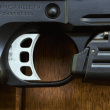
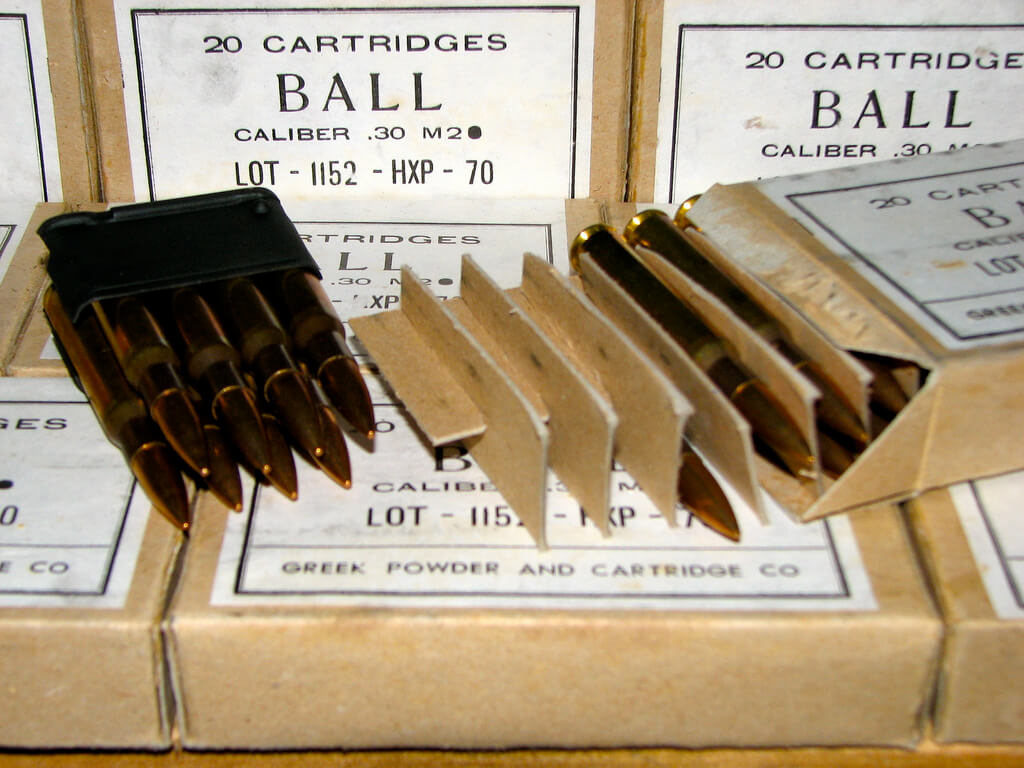
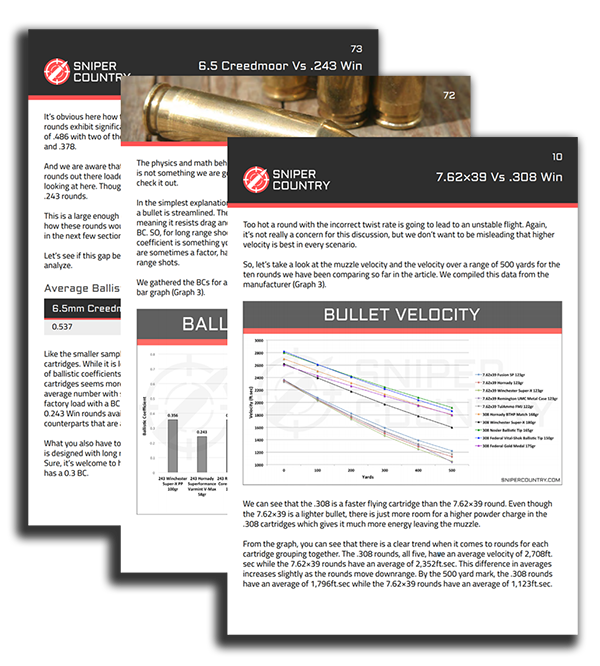

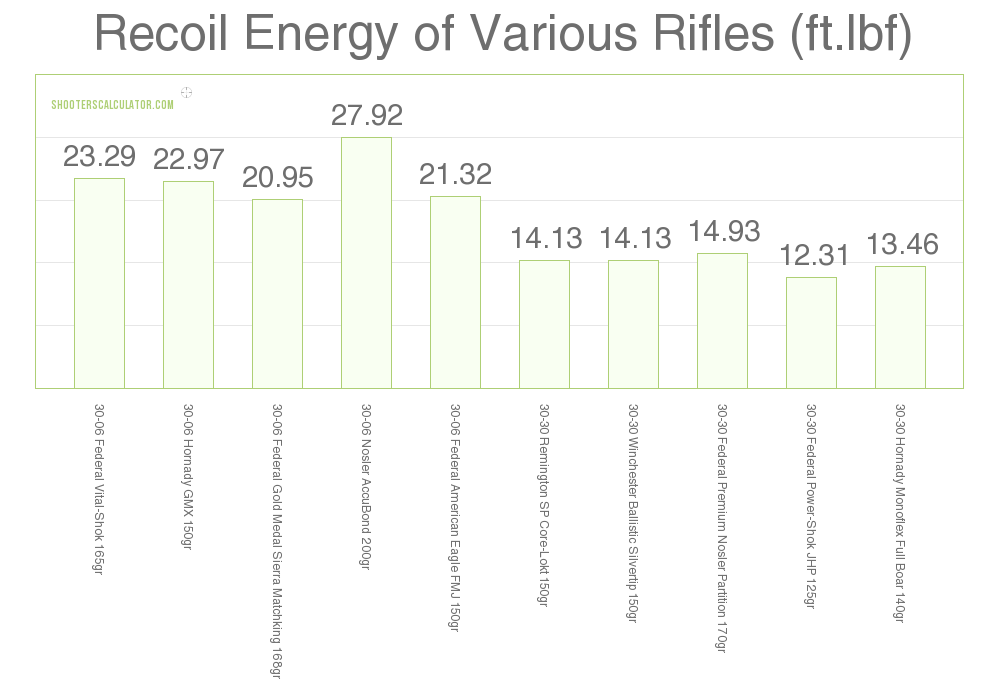
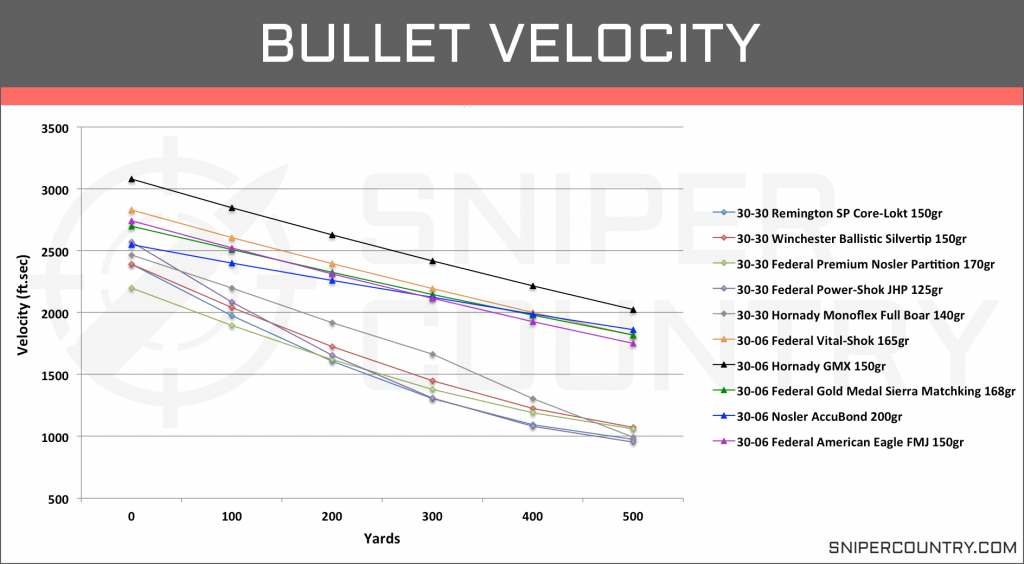
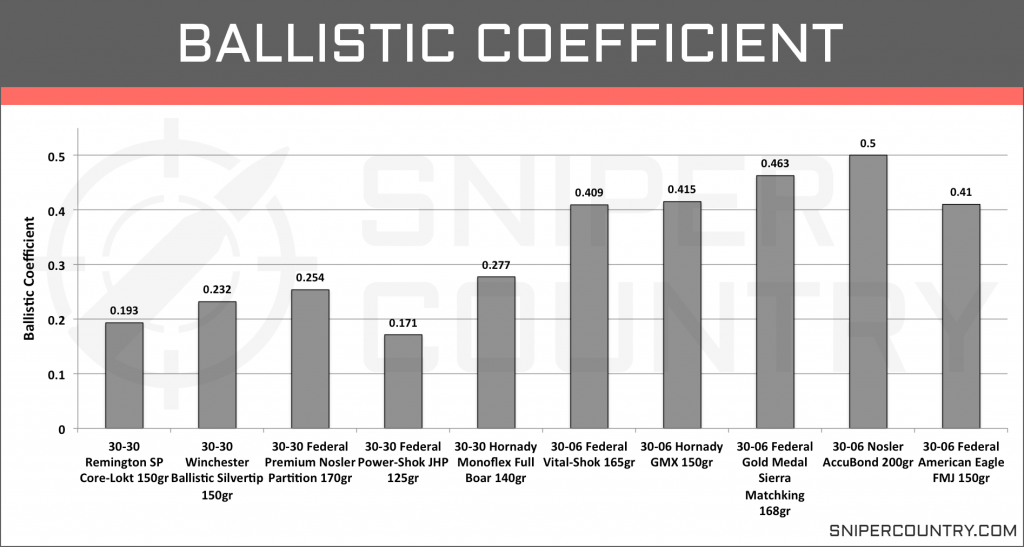
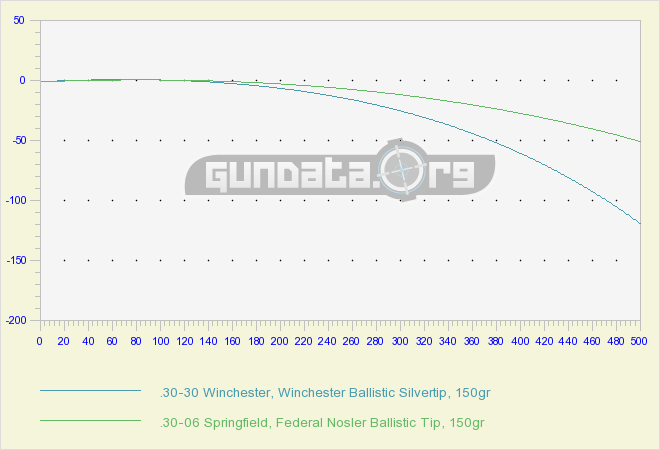
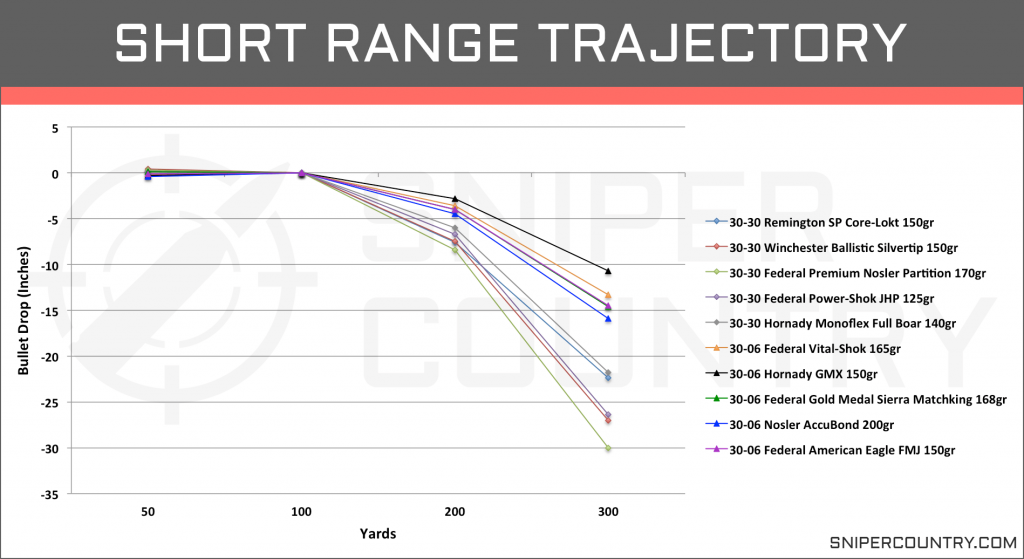
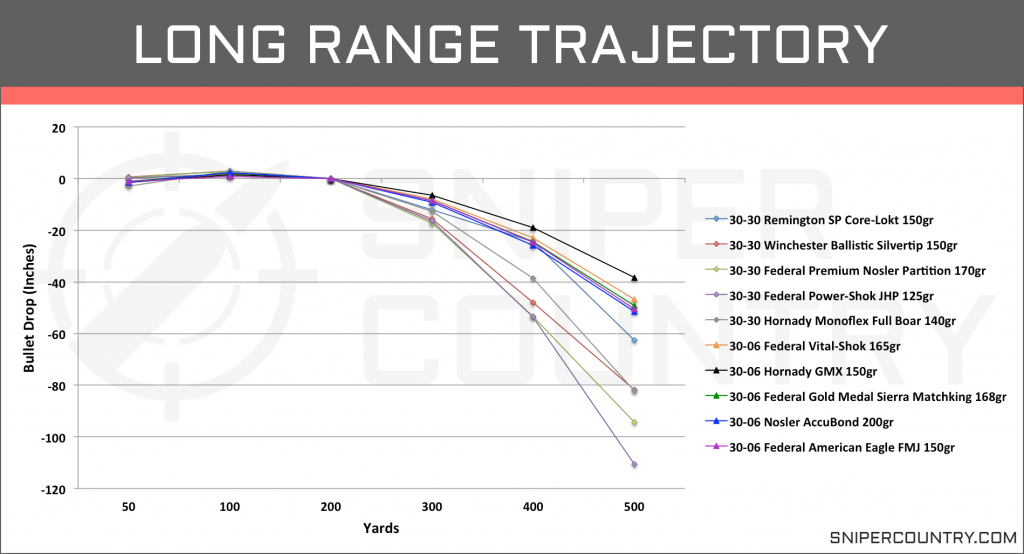
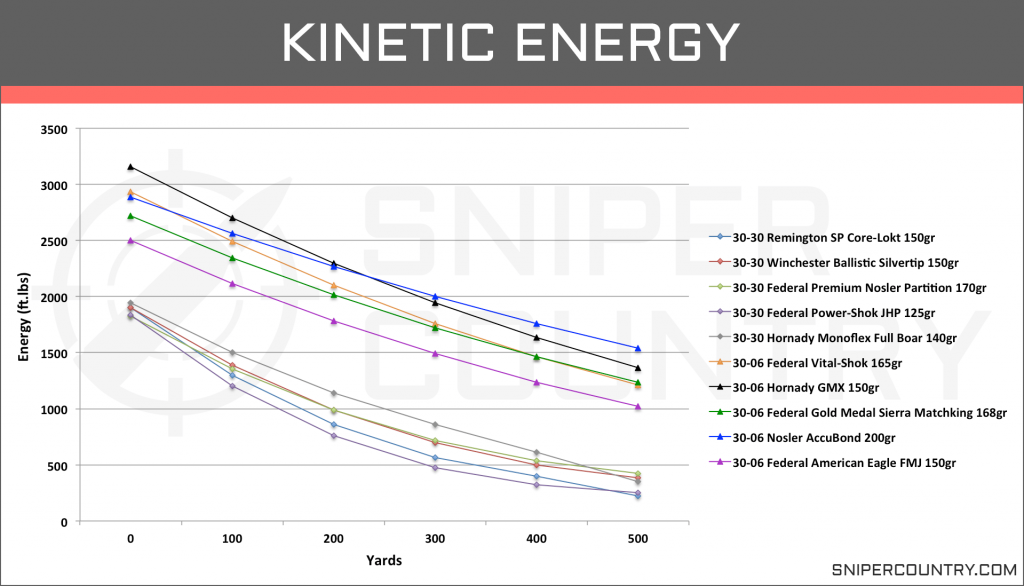
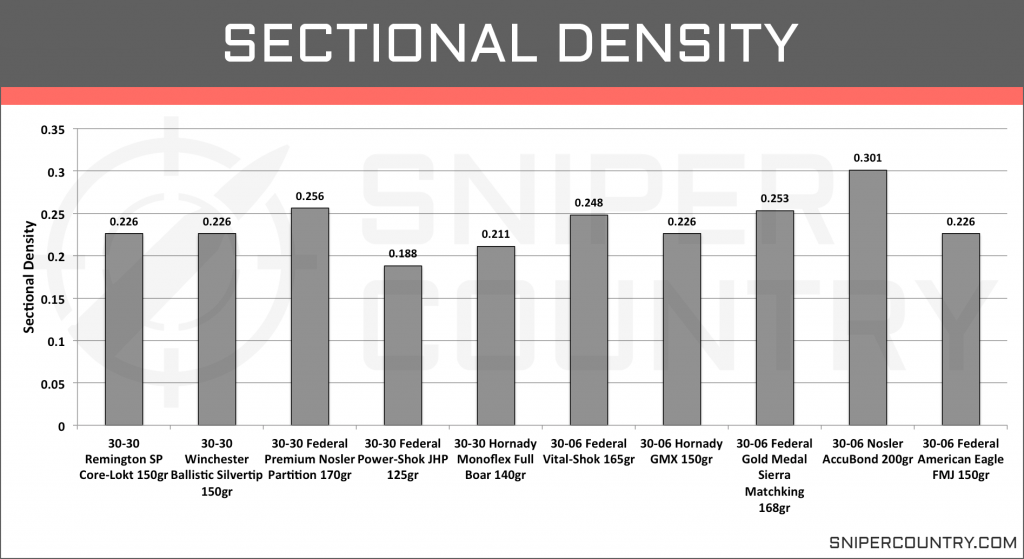
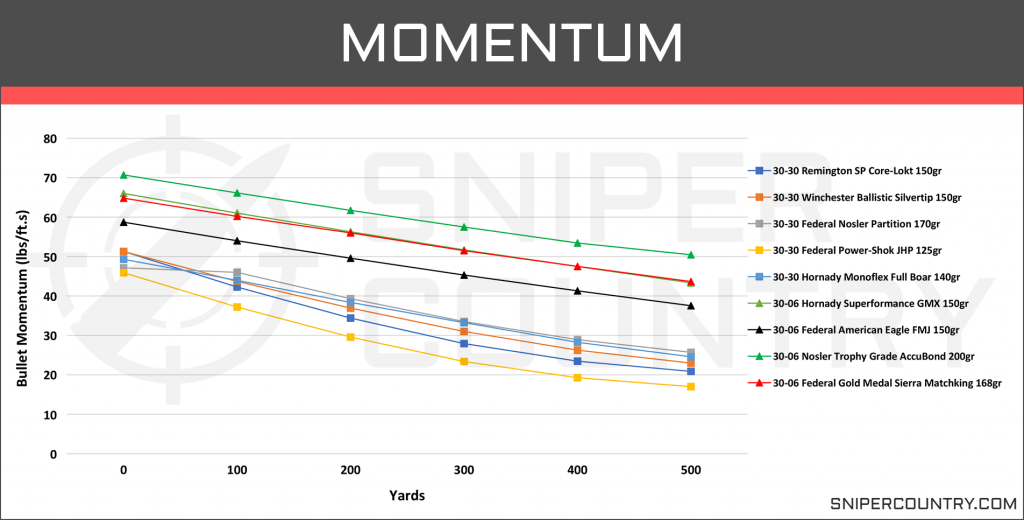

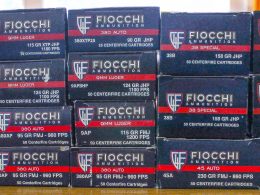
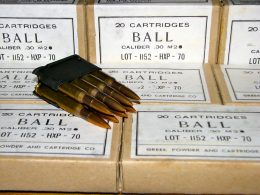
Excellent and in-depth analysis, thanks for writing it.